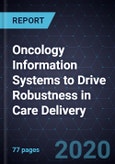Future Growth Potential Lies in Precision Medicine and Cloud Adoption in Oncology Care
As cancer care becomes increasingly highly complex, the information, image data, and steps that comprise a single patient’s healthcare journey has grown tremendously. Oncology information systems (OIS) software are used by cancer clinics and departments, medical oncologists, radiation specialists, and department employees to manage and plan the treatment module of cancer patients. Automation of the oncology workflow with the EMR not only delivers greater department efficiency but can also help in improving the quality of care, reducing medical errors, decreasing clinical documentation time, providing rich data for clinical research, and controlling health costs.
The software has evolved over the last decade as a tool to centralize the patient’s electronic medical record (EMR) in an easily accessible place and to manage the treatment process from referral to treatment and eventually disease management. The main market participants are Elekta and Varian that are also major radiation equipment manufacturers. Their large customer base in radiation centers and the integration capabilities that their software offers with their radiation equipment are major positives. Oncology has been a ripe space for healthcare IT systems in the recent past, and EHR companies such as Epic and Cerner have made a place for themselves with oncology-specific EHRs and data analytics capabilities. Data analytics and visualization tools have also gained importance with increasing sophistication of the disease.
The global OIS market is driven by associated advantages of OIS over conventional record maintenance, and surge in prevalence of cancer worldwide. In addition, rise in awareness of the benefits of using OIS is expected to fuel the market growth. The adoption of OIS developed by software vendors will increase in the coming years as health systems and hospitals realize the value they bring in the maintenance of systems, regular updates, and training, as they focus solely on software development. Further, EHR and other software vendors will invest in R&D to develop stronger OIS solutions and focus on interoperability with current radiation equipment.
Integration of oncology information systems into main hospital workflows, shift to the cloud, and increased usage of artificial intelligence (AI) in oncology information systems are slated to be growth opportunities for key market participants in the near future. Increased sophistication of OIS will take place as value-based rules come into the picture, patient engagement takes center stage, and telehealth becomes the new normal (post COVID-19). An OIS will have to encompass all the market dynamics to stay relevant to oncology practices around the world.
Table of Contents
Companies Mentioned (Partial List)
A selection of companies mentioned in this report includes, but is not limited to:
- Elekta
- Epic Systems
- Philips
- RaySearch Laboratories
- Varian Medical Systems








